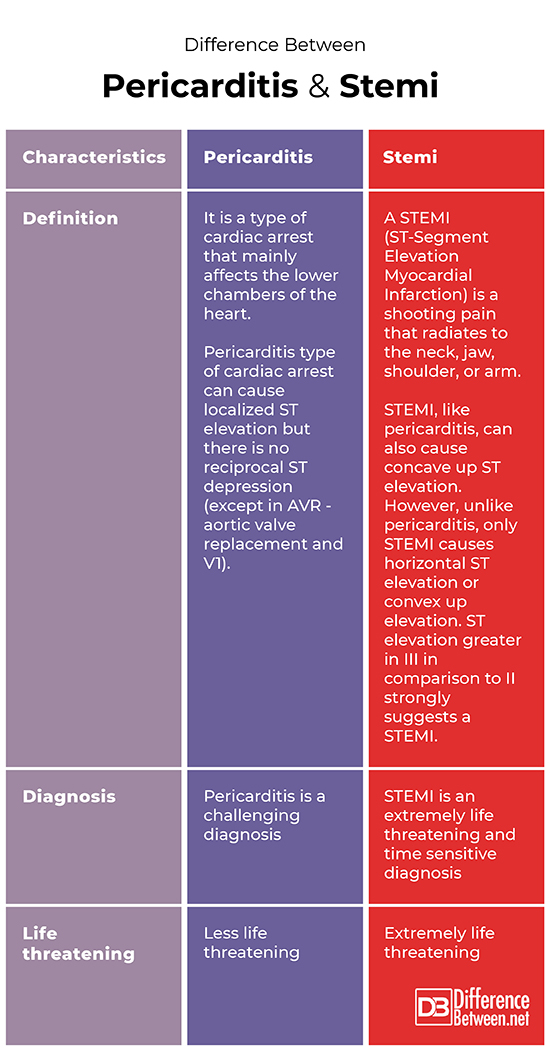Difference Between Pericarditis and Stemi

What is Pericarditis and Stemi
Pericarditis can cause localized ST elevation (a reading on an electrocardiogram wherein the trace in the ST segment is erratically high above the baseline) but there should be no reciprocal ST depression (except in aortic valve replacement and V1 – primary visual cortex). STEMI (ST-elevation myocardial infarction), just like pericarditis, can also cause concave up (When the slope continually increases, the function is concave upward) ST elevation. Only ST-elevation myocardial infarction (STEMI) results in convex up or horizontal ST elevation. ST elevation (electrocardiogram reading) greater in III than II strongly suggests a STEMI.

Similarity
Symptoms and ECG findings in both pericarditis and stemi look similar.
Pericarditis
Pericarditis is inflammation of the pericardium (a thin, 2-layered, fluid-filled sac which covers the outer surface of the heart)
Stemi
It is a type of heart attack that mainly affects the lower chambers of your heart. STEMI means an ST-elevation myocardial infarction
Difference between Pericarditis and stemi
Definition
Pericarditis
It is a condition in which there is a swelling and discomfort of the thin, sac-like envelop surrounding the heart (pericardium). It causes chest pain which is sharp and stabbing. It also causes dry cough, anxiety and fatigue.
Stemi
It is a category of heart attack which mainly impacts the lower chambers of your heart.
ECG finding
Pericarditis
Absence of Spodick’s sign – 71%
Convex ST – 31%
Stemi
Absence of Spodick’s sign – 95%
Convex ST – 7%
Causes
Pericarditis
It is caused by autoimmuno diseases, infection, inflammation or swelling post heart attack, malignancy (cancer), injury of chest, HIV, tuberculosis (TB), AIDS, kidney failure, heart surgery, medical treatments like radiation therapy for the chest.
Stemi
It is commonly caused by an acute occlusion (the blockage of a blood vessel or hollow organ) of a coronary blood vessel secondary to acute plaque rupture (an area of fibrous cap disruption) and thrombosis. However, cocaine use can also trigger STEMI because of coronary vasospasm.
Summary
The points of difference between Pericarditis and Stemi have been summarized as below:

FAQ
Why does pericarditis cause ST elevation?
The electrocardiographic (process of producing an electrocardiogram (ECG or EKG)) change along with pericarditis consist of ST elevation (a finding on an electrocardiogram wherein ST segment trace is erratically and unusually high above the baseline) in most of the leads of the twelve-lead electrocardiogram. The source of this ST elevation is the local inflammatory modifications in the epicardium (the outermost layer of the heart) underlying the inflamed pericardium.
Are there always ECG changes with pericarditis?
Interestingly, pericarditis patients with increased biomarkers of myocardial injury (molecules found in blood, or tissues that is a symptom of the condition or disease) almost always exhibit electrocardiogram changes characteristic of a diagnosis wherein the trace in the ST segment is erratically high above the baseline (ST-segment elevation)
Pericarditis is usually associated with electrocardiogram changes that evolve through 4 stages. Less than fifty percent of patients progress through all 4 classical phases and evolution of alterations may not follow this typical pattern.
Is pericarditis a heart attack?
A common symptom of pericarditis is chest pain and abnormal heart rythms which makes it similar to the symptoms of a heart attack. However, the real meaning of pericarditis is the inflammation of pericardium (a thin, 2-layered, fluid-filled sac that envelops the outer surface of the heart
- Difference Between Global Warming and Greenhouse Effect - May 18, 2024
- Difference Between Vaccination and Immunization - March 3, 2024
- Difference Between Selective Mutism and Autism - February 25, 2024
Search DifferenceBetween.net :
Leave a Response
References :
[0]Bates, E. R., & Jacobs, A. K. (2013). Time to treatment in patients with STEMI. The New England journal of medicine, 369(10), 889-892.
[1]Imazio, M., & Gaita, F. (2015). Diagnosis and treatment of pericarditis. Heart, 101(14), 1159-1168.
[2]McManus, D. D., Gore, J., Yarzebski, J., Spencer, F., Lessard, D., & Goldberg, R. J. (2011). Recent trends in the incidence, treatment, and outcomes of patients with STEMI and NSTEMI. The American journal of medicine, 124(1), 40-47.
[3]Troughton, R. W., Asher, C. R., & Klein, A. L. (2004). Pericarditis. The Lancet, 363(9410), 717-727.
